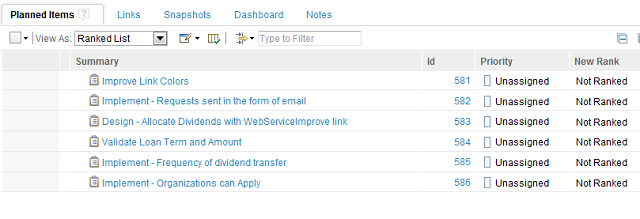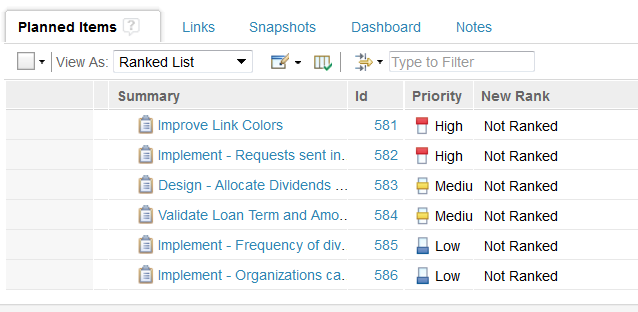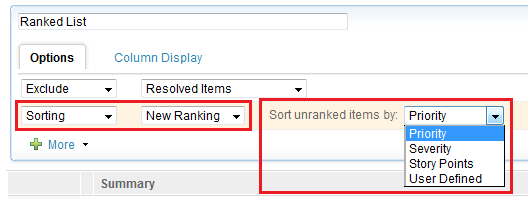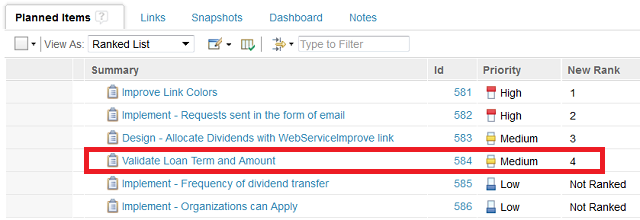Understanding ranking in Rational Team Concert 4.0.3
Ranking helps you to organize and prioritize work items in a plan. In Rational Team Concert 4.0.3, a new ranking method includes a new sorter and rank attribute making ranking in a plan clearer and easier to use. For details on how the old ranking method works, see Understanding ranking in Rational Team Concert 4.0.
Note: All references regarding the new ranking functionality are applicable only to the New Rank attribute (which shows you the new rank changes of an item). The old ranking strategy and Rank attribute (which showed you the old rank of an item) is unaffected by these actions. As a result two separate strategies to rank items exist independently from one another.
For all examples below, the project uses the Scrum template. The term ranking refers to the new ranking methods. Initially, all priorities are unassigned and the order of the items is based on the ID of the work item (and, in turn the order in which they were created).

Items now have priorities. In the example below, the top two are high priority, the next two are medium priority and the bottom two are low priority. You can now assign ranks to items.

Setting up ranking in a plan
To setup ranking, open any plan view and edit the view as follows:
1) Set the sorting option to New Ranking2) Choose the sorting option for unranked items (eg. Priority)

4) Search for the New Rank attribute, and then add the column

How does the new sorting work?
1) If an item has a rank, its position in the plan is determined by its rank value. Ranked items are listed first, followed by unranked items.2) If an item does not have a rank, its position is determined by the value of the attribute used as a sorter for unranked items. For example, high-priority items come first, followed by all of the medium-priority items and then all of the low-priority items.

New options to rank within a plan
You can rank items (or remove rank) within a plan using four different methods:
1) The Apply Rank action2) Context-menu options
3) Drag-and-drop action
4) Rank Integer Edit action
Apply Rank
The apply rank option is a global action which ranks all the items in a plan at once. Performing this action assigns a rank value to all items in a plan in serial order based on the current position of the items in the plan.
Note: If you have no further items to rank, Apply Rank does nothing, and the plan does not show changes. However, if some of the items are ranked through other options, or if items are hidden from the plan through filtering but were previously ranked, clicking Apply Rank causes the rank to be removed from these items, and the plan changes to an unsaved state.

Context-menu options
1) Remove > New Rank: This action removes the rank associated with the item. If the item is not currently ranked, it is disabled. In the following example, the operation is applied to the item, “Implement – Frequency of dividend transfer”.

2) Remove > New Rank Below: This action removes the rank of all the items below the current selected item. In the following example, this action is applied to the item, “Design – Allocate Dividends with WebServiceImprove link”.




Drag and Drop
Although drag and drop existed in the previous ranking model, there are a few changes in its behavior in the new model.
1) If you drag an item to the top of a plan, it gets ranked 1, and the ranks of all ranked items below it are increased by 1, as shown in the following example when the item, “Validate Loan Term and Amount”, is dragged to the top of the list.


1) The scenario mentioned in the third point of the drag-and-drop method is not applicable to a user-defined sorter for unranked items, where although the item loses its rank, its sort attribute for unranked items is not changed to that of its predecessor. When dragging an item into a group of unranked items, it loses its rank, but its sort attribute for unranked items does not change, as seen with the item, “Improve Link Colors”.

Rank Integer Edit
You can also directly edit the rank value of an existing item to specify a new integer rank. Click the rank cell that corresponds to the rank that you want to change, and type the new rank value.
Based on the rank number that you type, the item and all subsequent ranked items are re-ranked accordingly. In the following example, a new rank value is given to the item, “Improve Link Colors”.



Creating a custom sort attribute for unranked items
The sort attribute for unranked items drop-down list is populated by the existing enumerations in the system. To create a custom sort attribute for unranked items, you must create a custom enumeration. You can find more information on creating a custom enumeration at Using a Custom Ranking Attribute for Planning.
In the following example, the Importance column is a custom attribute with four categories: Not Important, Light, Essential and Crucial. The weight of the items increase from lowest to highest. In an unranked plan with items having their importance assigned, setting the secondary sort attribute to the Importance enumeration results in a sorted order as shown below.

You can see that the plan is now using the Importance attribute for the plan item during sorting. All the unranked plan items (in this case, all of the items) are now sorted according to their importance, starting with the most important to the least important.
For additional information about the topic presented in the article add your comments or questions directly in the discussion part, or visit our Jazz.net Forum.
Copyright © 2013 IBM Corporation